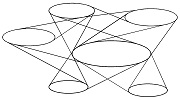


 |
 |
 |
Vehicle Efficiency Fraud
Electric vehicles are worse than gas vehicles for emissions and inefficiency. There are two major frauds in the claims for electric vehicles. One is the claim of 100 to 150 miles per gallon equivalent with electric vehicles. The other is omitting the source of energy. The discrepancy is based upon theoretical falsehoods and factors being omitted. Bureaucrats claim electric motors get 96% efficiency (1). Nothing could be a bigger fraud in engineering. Linearized electrons produce large amounts of heat in traveling through metals including transformations into kinetic energy. (Heat production is the wasted energy causing inefficiency of electricity.) There is no theoretical possibility in getting more than 40% efficiency in transforming electric energy into kinetic energy at normal temperatures due to the heat electrons produce in bumping into metal atoms (2). That's ten times more heat produced in electric motors than bureaucrats claim. The omissions include skipping over the fact that 70 to 90% of electrical energy is lost getting to consumers (3). The primary loss is along transmission lines, where resistance in metals result in heat. Long lines have 50% loss built in, while shorter lines have about 20%. To reduce the loss from 50% to 25% would require two lines instead of one. Building more lines is so expensive and environmentally objectionable that the U.S. is short of transmission lines. Also skipped over is the fact that all electrical generators get no more than 40% efficiency including the newly popular natural gas generators. That factor alone eliminates the absurd claims of efficiency for electric vehicles. Apart from the misrepresentation of electric vehicles, the efficiency of gas vehicles is also a fraud. There is no technology that gets more than 25 miles per gallon (average conditions) with normal sized vehicles. Light weight vehicles will get slightly better mileage, but only under special conditions, not normal conditions. Light weight vehicles are designed for small spaces and low speeds, not U.S. highways. A large part of the misrepresentation for gas vehicles is in defining artificial conditions, such as uniform, optimal and theoretical test conditions in laboratories. Of course, everyone is supposed to know that the theoretical ideals are not going to apply to normal driving, except that there are a lot of gullible persons who do not know. And worse, the fakery builds, as the big numbers get embellished in political propaganda including requirements set by laws. Laws require future fleet averages in the area of 55 miles per gallon equivalent, with the auto industry aiming for 51 mpge and conservatives aiming for a lower target at the federal level. Such ridiculous numbers to a point of fraud have the primary purpose and effect of forcing expensive technology onto society, primarily through electric vehicles and renewable energy fakery. You say, prove it. No one bothers to prove a thing in perpetrating the fraud, but the critics are supposed to do the proving. The criticism is based on science and engineering, while the fraud is based upon gullibility of the public. Bureaucratic claim of 96% efficiencySelf-driving is absurd and has no real purpose
|
| ||||||||||||||||
 |
 | |